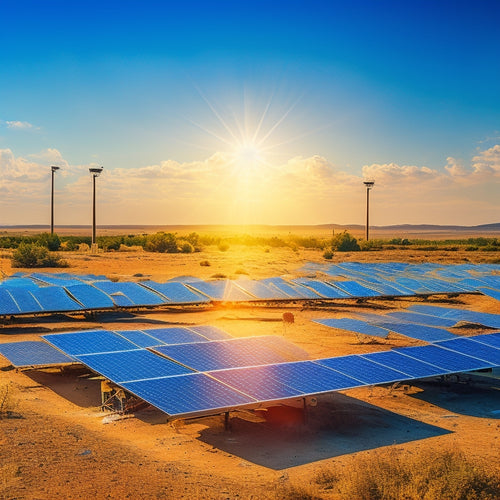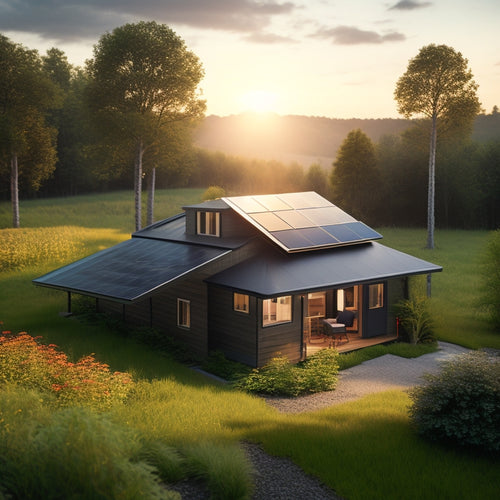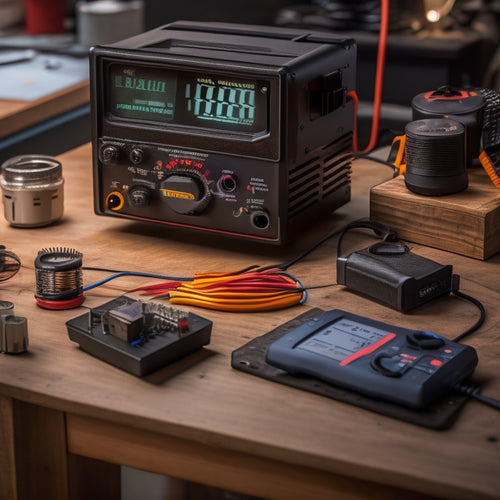
Diy Solar Panel Kits
Share
You can reduce your electricity bills by up to 50% with a DIY solar panel kit, which utilizes clean energy and provides financial benefits. These kits offer customizable solutions that overcome high installation costs and space constraints of traditional systems. With optimized inverters and Max Power Point Tracking technology, you can maximize energy production. To estimate daily energy output, you'll need to evaluate the wattage per hour rating of your kit and peak sun hours in your region. By selecting the right kit with a suitable warranty, you'll secure a sustainable future and investment security - and that's just the starting point for your solar adventure.
The Essentials
- DIY solar panel kits can save up to 50% on electricity bills and provide long-term financial benefits by generating clean energy.
- Customizable solar solutions overcome high installation costs and space constraints of traditional systems, making them a cost-effective option.
- DIY solar kits promote energy independence, reduce environmental impact, and contribute to a sustainable future by minimizing carbon footprint.
- High-efficiency inverters and optimized panel angles enhance energy production, while real-time monitoring allows for adjustments to maximize savings.
- Extended warranties offer financial security and peace of mind, ensuring a reliable and long-lasting DIY solar panel kit investment.
Save Money on Electricity
By installing a DIY solar panel kit, you'll greatly lower your electricity bills and cut energy costs.
With solar power, you'll generate your own clean energy, reducing your reliance on the grid and the amount you pay to your utility company.
By utilizing the power of the sun, you'll also reduce your carbon footprint, contributing to a more sustainable future Renewable Energy Solutions.
As a result, you'll enjoy considerable savings on your electricity expenses over time.
Lower Your Bills
You're likely considering DIY solar panel kits because you want to reduce your electricity costs. By utilizing the sun's energy, you can considerably lower your bills and break free from reliance on the grid.
With a DIY solar panel kit, you'll be able to generate your own clean energy and enjoy the financial benefits that come with it. By embracing renewable energy, you can overcome common challenges such as high installation costs and space constraints that often limit traditional solar panel systems.
To maximize your savings, it's crucial to follow proper installation tips and maintenance guidelines. Confirm your solar panels are installed at the best angle and direction to capture the most sunlight.
Regularly clean your panels to maintain their efficiency, and inspect your system for any signs of wear or damage.
Cut Energy Costs
With your DIY solar panel kit in place, you're ready to reap significant savings on your electricity bills. By utilizing the power of the sun, you'll reduce your reliance on traditional energy sources and cut your energy costs. A typical solar installation can save you up to 50% on your electricity bills, depending on your energy usage and the size of your solar panel array.
By investing in a DIY solar panel kit, you'll be joining the growing community of homeowners who are taking advantage of residential renewable energy solutions to reduce their environmental impact. Additionally, with a DIY solar panel kit, you'll have the freedom to choose from a range of solar power systems for homes that fit your budget and energy needs.
To maximize your savings, it's crucial to conduct energy audits to identify areas of inefficiency in your home or business. By pinpointing energy-wasting appliances and habits, you can optimize your energy usage and get the most out of your solar panel kit. By reducing your energy consumption, you'll not only save money but also reduce your carbon footprint.
With a DIY solar panel kit, you'll have full control over your energy production and consumption. You'll be able to monitor your energy usage in real-time, making adjustments as needed to optimize your savings.
Renewable Energy Source Guarantee
You're investing in a DIY solar panel kit to gain energy independence today.
By capturing sunlight, you'll generate clean power and reduce your reliance on traditional energy sources.
With the ability to customize your solar solution, you can design a system that meets your specific energy needs, whether that's for off-grid living or supplementing your existing power supply.
With a renewable energy source guarantee, you can rest assured that your solar panels will produce consistent, sustainable energy for years to come.
Energy Independence Today
Your path to energy independence begins today, as governments and companies worldwide guarantee a renewable energy source through various incentives and policies.
You're no longer bound to traditional energy providers, and this freedom translates to energy security. With DIY solar panel kits, you can tap into sustainable living, reducing your reliance on fossil fuels and mitigating your carbon footprint.
As you commence on this expedition, you'll find that renewable energy sources are becoming increasingly cost-competitive with traditional energy sources.
This shift is driven by advancements in technology, economies of scale, and policy support. You're not alone in this pursuit; millions of individuals and businesses are already utilizing the power of renewable energy to achieve energy independence.
Clean Power Generation
Solar power systems employ photovoltaic (PV) cells to convert sunlight into electricity, guaranteeing a clean power generation process that's both sustainable and renewable.
As you shift to DIY solar panel kits, you're not only reducing your reliance on fossil fuels but also contributing to a cleaner environment. You'll be leveraging the power of solar technology to generate electricity, minimizing your carbon footprint and mitigating climate change.
The environmental benefits of clean power generation are undeniable. By choosing solar energy, you're reducing air pollution, conserving water, and protecting ecosystems.
You're also supporting a renewable energy source that's abundant and available everywhere. With solar power, you're in control of your energy generation, free from the volatility of fossil fuel prices and supply chain disruptions.
As you take charge of your energy needs, you're promoting energy independence and a sustainable future. By embracing clean power generation, you're investing in a healthier planet and a brighter tomorrow.
Inverter Efficiency Matters Most
When you're building a DIY solar panel kit, you'll want to make certain your inverter is optimized for maximum energy harvest, especially considering the importance of reliable energy storage for solar power solutions off grid solar system to guarantee continuous power during outages and nights.
This means looking for an inverter with high conversion efficiency rates, as well as Max Power Point Tracking (MPPT) capabilities to adapt to changing environmental conditions.
Max Power Point Tracking
Since the primary function of an inverter is to convert DC power from your solar panels into AC power for your home, its efficiency plays a critical role in determining how much energy your system can produce.
You'll want to verify your inverter is equipped with max power point tracking (MPPT) technology, which enhances energy harvesting by identifying the maximum power point of your solar panels.
This advanced feature allows your inverter to adapt to changing environmental conditions, such as temperature and sunlight, to maximize energy production.
By incorporating MPPT into your solar technology, you can achieve ideal panel optimization, resulting in increased energy yields and reduced energy losses.
With MPPT, your inverter can track the maximum power point of your solar panels in real-time, guaranteeing you're getting the most out of your solar investment.
This state-of-the-art technology is essential for maximizing the performance of your DIY solar panel kit and achieving energy independence.
High Conversion Efficiency Rate
Optimism fuels your pursuit of energy independence, and it's the inverter's conversion efficiency rate that ultimately makes this vision a reality. A high conversion efficiency rate is essential, as it directly impacts the amount of usable energy your DIY solar panel kit produces.
With advancements in solar panel technology, modern inverters boast impressive efficiency improvements. When selecting a DIY solar panel kit, look for an inverter with a high conversion efficiency rate, typically above 95%. This guarantees that the maximum amount of power is extracted from the sunlight.
A high-efficiency inverter reduces energy losses, resulting in more power for your home and a faster return on investment. Inverters with high conversion efficiency rates often feature state-of-the-art design and premium components.
These advanced designs enable the inverter to operate at peak levels, even in challenging environmental conditions. By choosing a DIY solar panel kit with a high-efficiency inverter, you're taking a significant step towards achieving energy independence and minimizing your reliance on the grid.
Check Wattage Per Hour
You'll need to calculate the daily energy output of your DIY solar panel kit, which depends on the wattage per hour it can produce.
To do this, you'll need to take into account the peak sun hours your location receives, as this will impact the overall energy production.
When designing your system, it's crucial to reflect on renewable energy storage and how it can help you generate clean energy and save on electricity bills.
Daily Energy Output
How much energy can you realistically expect to generate from your DIY solar panel kit on a daily basis? This question is vital in determining the viability of your solar panel kit.
To answer this, you need to conduct a daily performance analysis of your system. Start by checking the wattage per hour rating of your solar panel kit. This rating is usually indicated on the manufacturer's label or documentation.
Next, you need to monitor your energy production over a typical day. This can be done using an energy production monitoring system, which tracks the amount of electricity generated by your solar panel kit at regular intervals.
By analyzing this data, you can determine your daily energy output in watt-hours (Wh).
For example, if your solar panel kit has a wattage per hour rating of 300 watts and it produces electricity for 5 hours a day, your daily energy output would be 1500 Wh or 1.5 kilowatt-hours (kWh).
This information is fundamental in determining how much energy you can realistically expect to generate from your DIY solar panel kit on a daily basis.
Peak Sun Hours
The wattage per hour rating of your DIY solar panel kit is directly tied to the amount of peak sun hours your location receives. Peak sun hours refer to the amount of solar energy available at your location, which affects the performance of your solar panel kit. This is vital because it determines how much electricity your kit can generate.
To give you a better understanding, here's a breakdown of peak sun hours in different regions:
| Region | Peak Sun Hours/Day | Sunlight Availability |
|---|---|---|
| Desert | 6-7 | High |
| Tropical | 5-6 | Medium-High |
| Temperate | 4-5 | Medium |
| Northern Latitudes | 3-4 | Low-Medium |
When choosing a DIY solar panel kit, consider the peak sun hours in your area to make sure you're getting the right system for your needs. A higher peak sun hour rating means more solar energy is available, resulting in more electricity generated. By understanding peak sun hours, you can optimize your solar energy output and enjoy the freedom that comes with utilizing renewable energy.
Longer System Lifespan Guaranteed
You're likely thinking about the long-term reliability of your DIY solar panel kit.
That's where extended warranty options come into play, providing you with added peace of mind and financial security.
Extended Warranty Options
Solar panel manufacturers often provide extended warranty options to guarantee a longer system lifespan. When you're investing in a DIY solar panel kit, you want to verify your system lasts for years to come. Extended warranties provide peace of mind and protect your investment.
| Warranty Terms | Coverage Options |
| 10-year warranty | 90% power output guarantee |
| 15-year warranty | 85% power output guarantee |
| 20-year warranty | 80% power output guarantee |
| 25-year warranty | 75% power output guarantee |
You'll typically find that manufacturers offer varying warranty terms, each with its own set of coverage options. The longer the warranty, the more thorough the coverage. For instance, a 25-year warranty might guarantee 75% power output, while a 10-year warranty might guarantee 90%. When choosing an extended warranty, consider the warranty terms and coverage options that best fit your needs and budget. By doing so, you'll be able to enjoy a longer system lifespan and maximize your return on investment.
Frequently Asked Questions
Can I Install a DIY Solar Panel Kit Myself?
You can install a DIY solar panel kit yourself, but be prepared to steer through the complex installation process and weigh cost considerations, ensuring a safe and efficient setup that meets your energy needs and local building codes.
Are DIY Solar Panel Kits Compatible With All Roof Types?
As you scale the rooftop, imagine a puzzle piece fitting perfectly - but, you'll find that not all roof materials are created equal, and installation challenges arise with clay tiles, slate, or metal roofs, requiring careful consideration before you start.
Do DIY Solar Panel Kits Come With a Warranty?
When you invest in a solar panel kit, you'll typically find that it comes with a warranty, which outlines the warranty terms and guarantees product longevity, giving you peace of mind and protection for your investment.
Can I Expand My DIY Solar Panel Kit in the Future?
Imagine building with LEGOs - you start with a foundation, then add blocks as needed. Similarly, you can expand your solar panel system in the future, exploring various expansion options and future upgrades, as your energy needs evolve, without being locked into a fixed setup.
Are DIY Solar Panel Kits Suitable for Off-Grid Systems?
When you're living off the grid, you need a system that's optimized for off-grid efficiency. You'll face installation challenges, but with careful planning, you can overcome them and achieve energy independence, which is where DIY solar panel kits can come into play.
Final Thoughts
Now that you've made it through the DIY solar panel kit gauntlet, pat yourself on the back - you're about to save a pretty penny on electricity. But let's not get ahead of ourselves; remember, a renewable energy source guarantee is only as good as the inverter efficiency that backs it. And don't even get us started on wattage per hour - you'd be surprised how quickly those numbers add up. The real prize, though, is a longer system lifespan. Because what's the point of going green if you're just going to replace it all in a few years?
Related Posts
-

What Happens Without a Charge Controller in Solar Panels
Without a charge controller in your solar panel system, you risk overheating batteries due to overcharging, which can...
-

Diy Off Grid Solar
By embracing DIY off-grid solar, you can break free from grid dependence, slashing your energy bills by up to 90% and...
-

Key Features of a DC to AC Converter
A DC to AC converter features high efficiency and conversion rates, which reduce energy costs and improve performance...


